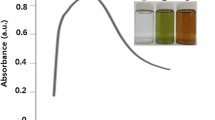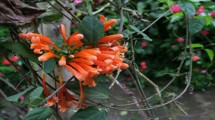Abstract
The current research was aimed to carry out the synthesis and characterization of silver nanoparticles (AgNPs) from the Acacia nilotica leaf extract mediated compound pyrogallol (py). The py-AgNPs were evaluated for in vitro antioxidant, antimicrobial, and biofilm activities against Helicobacter pylori (H. pylori). Further, the apoptotic induction of human gastric adenocarcenoma (AGS) cells was also investigated. Characterization of py-AgNPs was evaluated by using Fourier transform infrared spectroscopy (FT-IR), High-resolution transmission electron microscopy (HR-TEM), Scanning electron microscopy (SEM), Zeta potential, dynamic light scattering (DLS), X-ray diffraction (XRD) and UV–visible spectrometry. The average size of py-AgNPs was 22.68–55.16 nm in range, confirmed by HR-TEM. The clear H. pylori biofilm and bacterial inhibition were observed by increasing the concentration. The 3-(4,5-dimethylthiazol-2-yl)-2,5-diphenyltetrazolium bromide (MTT) assay on AGS cells were revealed that the increasing py-AgNPs level, significantly decreases the cell viability by increased apoptosis. The cell cycle arrest was observed. These results indicate that py-AgNPs have a vital function as an anti-H. pylori and anti-gastric cancer inhibitor and could be further used in the development of nanomedicines to counter lethal diseases.



Similar content being viewed by others
References
D. Kalaimurugan, P. Sivasankar, K. Lavanya, M. S. Shivakumar, and S. Venkatesan (2019). Antibacterial and larvicidal activity of Fusarium proliferatum (YNS2) whole cell biomass mediated copper nanoparticles. J. Clust. Sci. 30, 1071–1080. https://doi.org/10.1007/s10876-019-01568-x.
P. Sivasankar, S. Poongodi, P. Seedevi, D. Kalaimurugan, M. Sivakumar, and S. Loganathan (2019). Nanoparticles from Actinobacteria: a potential target to antimicrobial therapy. Curr. Pharm. Des. 25, 2626. https://doi.org/10.2174/1381612825666190709221710.
Cancer-World Health Organization. https://www.who.int/news-room/factsheets/detail/cancer Accessed March 21, 2019.
S. Kienesberger and E. L. Zechner (2017). Helicobacter pylori. Ref. Module Biomed. Sci.. https://doi.org/10.1016/B978-0-12-801238-3.99201-8.
C. Y. Kao, B. S. Sheu, and J. J. Wu (2016). Helicobacter pylori infection: an overview of bacterial virulence factors and pathogenesis. Biomed. J. 39, 14–23. https://doi.org/10.1016/j.bj.2015.06.002.
F. Iwanczak and B. Iwanczak (2012). Treatment of Helicobacter pylori infection in the aspect of increasing antibiotic resistance. Adv. Clin. Exp. Med. 21, 671–680.
S. H. Lee and B. H. Jun (2019). Silver nanoparticles: synthesis and application for nanomedicine. Int. J. Mol. Sci. 17, E865. https://doi.org/10.3390/ijms20040865.
A. Moshfegh, A. Jalali, A. Salehzadeh, and A. Jozani (2019). Biological synthesis of silver nanoparticles by cell-free extract of Polysiphonia algae and their anticancer activity against breast cancer MCF-7 cell lines. Micro Nano Lett. 14, (5), 581–584. https://doi.org/10.1049/mnl.2018.5260.
S. Fahimirad, F. Ajalloueian, and M. Ghorbanpour (2019). Synthesis and therapeutic potential of silver nanomaterials derived from plant extracts. Ecotoxicol. Environ. Saf. 30, 260–278. https://doi.org/10.1016/j.ecoenv.2018.10.017.
S. W. Kim, Y. W. Han, S. T. Lee, H. J. Jeong, S. H. Kim, I. H. Kim, S. O. Lee, D. G. Kim, S. H. Kim, S. Z. Kim, and W. H. Park (2008). A superoxide anion generator, pyrogallol, inhibits the growth of HeLa cells via cell cycle arrest and apoptosis. Mol. Carcinogen.. https://doi.org/10.1002/mc.20369.
S. Revathi, F. L. Hakkim, N. R. Kumar, H. A. Bakshi, L. Rashan, M. Al-Buloshi, S. S. Hasson, M. Krishnan, F. Javid, and K. Nagarajan (2018). Induction of HT–29 colon cancer cells apoptosis by pyrogallol with growth inhibiting efficacy against drug-resistant Helicobacter pylori. Anticancer Agents Med. Chem. 18, 1875–1884. https://doi.org/10.2174/1871520618666180806104902.
L. Boyanova (2005). Activity of Bulgarian propolis against 94 Helicobacter pylori strains in vitro by agar–well diffusion, agar dilution, and disc diffusion methods. J. Med. Microbiol. 54, 481–483. https://doi.org/10.1099/jmm.0.45880-0.
F. Bugli, V. Palmieri, R. Torelli, M. Papi, M. de Spirito, M. Cacaci, S. Galgano, L. Masucci, F. Sterbini, A. Vella, R. Graffeo, B. Posteraro, and M. Sanguinetti (2016). In vitro effect of clarithromycin and alginate lyase against Helicobacter pylori biofilm. Biotechnol Prog. 32, 1584–1591. https://doi.org/10.1002/btpr.2339.
S. Niharika, P. Amrita, P. Asmitaand, and G. Gunjan (2016). Inhibition of quorum-sensing-mediated biofilm formation in Cronobacter sakazakii strains. Microbiology 162, 1708–1714. https://doi.org/10.1099/mic.0.000342.
M. Govindappa, R. Channabasava, K. S. Kumar, and K. C. Pushpalatha (2013). Antioxidant activity and phytochemical screening of crude endophytes extracts of Tabebuia argentea. Bur K Sch Am J Plant Sci. 4, 1641–1652.
M. Yadav, A. Yadav, and J. P. Yadav (2014). In vitro antioxidant activity and total phenolic content of endophytic fungi isolated from Eugenia jambolana Lam. Asian Pac. J. Trop. Med. 7, S256–S261.
I. Inkielewicz-Stepniak, M. J. Santos-Martinez, C. Medina, and M. W. Radomski (2014). Pharmacological and toxicological effects of co-exposure of human gingival fibroblasts to silver nanoparticles and sodium fluoride. Int. J. Nanomed. 9, (2014), 1677–1687. https://doi.org/10.2147/IJN.S59172.eCollection.
Q. Saquib, A. A. Al-Khedhairy, M. A. Siddiqui, F. M. Abou-Tarboush, A. Azam, and J. Musarrat (2012). Titanium dioxide nanoparticles induced cytotoxicity, oxidative stress and DNA damage in human amnion epithelial (WISH) cells. Toxicol. In Vitro. 26, 351–361. https://doi.org/10.1016/j.tiv.2011.12.011.
A. Moores and F. Goettmann (2006). The plasmon band in noblemetal nanoparticles: an introduction to theory and applications. NJC. 30, 1121–1132.
J. M. Pitark, V. M. Silkin, E. V. Chulkov, and P. M. Echenique (2005). Surface plasmons in metallic structures. J. Optic. Pure. Appl. Optic. 7, 73–84.
M. Amin, F. Anwar, M. R. Janjua, M. A. Iqbal, and U. Rashid (2012). Green synthesis of silver nanoparticles through reduction with Solanum xanthocarpum L. berry extract: characterization, antimicrobial, and urease inhibitory activities against Helicobacter pylori. Int. J. Mol. Sci. 13, 9923. https://doi.org/10.3390/ijms13089923.
R. Anjali, S. Palanisamy, M. Vinosha, M. Thenmozhi, P. Rajasekar, T. Marudhupandi, P. Kumar, P. Boomi, and M. P. Narayanan (2018). Phyto–mediated synthesis of silver nanoparticles using fucoidan isolated from Spatoglossum asperum and assessment of antibacterial activities. J. Photochem. Photobiol. B. 185, 117–125. https://doi.org/10.1016/j.jphotobiol.2018.05.031.
K. Gogoi, J. P. Saikia, and B. K. Konwar (2013). Immobilizing silver nanoparticles (SNP) on Musa balbisiana cellulose. Colloids Surf B. Biointerfaces. 102, 136–138.
Y. Zhao, Y. Jiang, and Y. Fang (2006). Spectroscopy property of Ag nanoparticles. Acta A. 65, 1003–1006.
S. K. Sivaraman, I. Elango, S. Kumar, and V. Santhanam (2009). A green protocol for room temperature synthesis of silver nanoparticles in seconds. Curr. Sci. 97, 1055–1099.
D. Prabhu, C. Arulvasu, G. Babu, R. Manikandan, and P. Srinivasan (2013). Biologically synthesized green silver nanoparticles from leaf extract of Vitex negundo L. induce growth–inhibitory effect on human colon cancer cell line HCT15. Process Biochem. 48, 317–324. https://doi.org/10.1016/j.procbio.2012.12.013.
S. Jain and M. Mehata (2017). Medicinal plant leaf extract and pure flavonoid mediated green synthesis of silver nanoparticles and their enhanced antibacterial property. Sci. Rep. 7, 15867. https://doi.org/10.1038/s41598-017-15724-8.
R. Kalaivani, M. Maruthupandy, T. Muneeswaran, A. H. Beevi, M. Anand, C. M. Ramakritinan, and A. K. Kumaraguru (2018). Synthesis of chitosan mediated silver nanoparticles (Ag NPs) for potential antimicrobial applications. Front. Lab. Med. 2, (1), 30–35. https://doi.org/10.1016/j.flm.2018.04.002.
A. Sudha, J. Jeyakanthan, and P. Srinivasan (2017). Green synthesis of silver nanoparticles using Lippia nodiflora aerial extract and evaluation of their antioxidant, antibacterial and cytotoxic effects. Resour.-Effic. Tech. 3, 506–515. https://doi.org/10.1016/j.reffit.2017.07.002.
Q. L. Feng, J. Wu, G. Q. Chen, F. Z. Cui, T. N. Kim, and J. O. Kim (2000). A mechanistic study of the antibacterial effect of silver ions on Escherichia coli and Staphylococcus aureus. J. Biomed. Mater. Res. 52, 662–668. https://doi.org/10.1002/1097-4636(20001215)52:4%3c662:aid-jbm10%3e3.0.co;2-3.
T. Hamouda, A. Myc, B. Donovan, A. Shih, J. D. Reuter, and J. R. Baker (2001). A novel surfactant nanoemulsion with a unique non–irritant topical antimicrobial activity against bacteria enveloped viruses and fungi. Microbiol. Res. 156, 1–7. https://doi.org/10.1078/0944-5013-00069.
J. S. Kim, E. Kuk, K. N. Yu, J. H. Kim, S. J. Park, H. J. Lee, S. H. Kim, Y. K. Park, Y. H. Park, C. Y. Hwang, and Y. K. Kim (2007). Antimicrobial effects of silver nanoparticles. Nanomedicine (Lond) 3, 95–101. https://doi.org/10.1016/j.nano.2006.12.001.
J. Premkumar, T. Sudhakar, A. Dhakal, J. Shrestha, S. Krishnakumar, and P. Balashanmugam (2018). Synthesis of silver nanoparticles (AgNPs) from Cinnamon against bacterial pathogens. Biocat. Agric. Biotechnol. 15, 311–316. https://doi.org/10.1016/j.bcab.2018.06.005.
R. Balachandar, P. Gurumoorthy, N. Karmegam, H. Barabadi, R. Subbaiya, K. Anand, P. Boomi, and M. Saravanan (2019). Plant-mediated synthesis, characterization and bactericidal potential of emerging silver nanoparticles using stem extract of Phyllanthus pinnatus: a recent advance in phytonanotechnology. J. Clust. Sci. 30, (6), 1481–1488. https://doi.org/10.1007/s10876-019-01591-y.
D. Davies (2003). Understanding biofilm resistance to antibacterial agents. Nat. Rev. Drug Discov. 2, 114–122.
H. Yonezawa, T. Osaki, S. Kurata, M. Fukuda, H. Kawakami, K. Ochiai, T. Hanawa, and S. Kamiya (2009). Outer membrane vesicles of Helicobacter pylori TK1402 are involved in biofilm formation. BMC. Microbiol. 9, 1–12. https://doi.org/10.1186/1471-2180-9-197.
A. V. Mariadoss, V. Ramachandran, V. Shalini, B. Agilan, J. H. Franklin, K. Sanjay, Y. G. Alaa, M. A. Tawfiq, and D. Ernest (2019). Green synthesis, characterization and antibacterial activity of silver nanoparticles by Malus domestica and its cytotoxic effect on (MCF-7) cell line. Microb. Pathog. 135, 103609. https://doi.org/10.1016/j.micpath.2019.103609.
H. Barabadi, M. A. Mahjoub, B. Tajani, A. Ahmadi, Y. Junejo, and M. Saravanan (2019). Emerging theranostic biogenic silver nanomaterials for breast cancer: a systematic review. J. Clust. Sci. 30, (2), 259–279. https://doi.org/10.1007/s10876-018-01491-7.
S. Salehi, S. A. Shandiz, F. Ghanbar, M. R. Darvish, M. S. Ardestani, A. Mirzaie, and M. Jafari (2016). Photosynthesis of silver nanoparticles using Artemisia marschalliana sprengel aerial part extract and assessment of their antioxidant, anticancer, and antibacterial properties. Int. J. Nanomed. 11, 1835–1846. https://doi.org/10.2147/ijn.s99882.
Acknowledgment
The authors would like to thank the Taiwan Experience Education Program, National Pingtung University, Taiwan, for providing laboratory facilities and financial support.
Author information
Authors and Affiliations
Corresponding author
Ethics declarations
Conflict of interest
The authors declare no conflict of interest.
Additional information
Publisher's Note
Springer Nature remains neutral with regard to jurisdictional claims in published maps and institutional affiliations.
Electronic supplementary material
Below is the link to the electronic supplementary material.
Rights and permissions
About this article
Cite this article
Sampath, G., Shyu, D.J.H., Rameshkumar, N. et al. Synthesis and Characterization of Pyrogallol Capped Silver Nanoparticles and Evaluation of Their In Vitro Anti-Bacterial, Anti-cancer Profile Against AGS Cells. J Clust Sci 32, 549–557 (2021). https://doi.org/10.1007/s10876-020-01813-8
Received:
Published:
Issue Date:
DOI: https://doi.org/10.1007/s10876-020-01813-8




